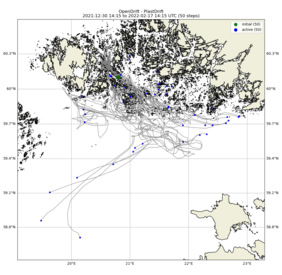At the beginning of this simulation, the butts were drifting around the Archipelago Sea, first towards north in a quite compact pack, but then this band of butts started to disperse and head on their own ways. Some continued to whirl around this area, occasionally coming ashore on some of the many islands and skerries, whereas some were drifting towards south, out to the open sea and limitless drifting opportunities. We see a continuation of this pattern, when we look into the movements of these butts from the last 4 weeks. The breakaway group has grown in numbers, as more butts have shaken of the shackles of the Archipelago Sea. Three distinctive groups have emerged, a few drifting towards west and the Stockholm Archipelago, some on a more southwestern course towards southern parts of Baltic Sea. Since there is no ice to the south, the butts on the south western course have no other physical obstacles in sight except the Swedish coast and the few bigger Islands on the east coast of Sweden, such as Gotland. The butts heading to west seem to be heading straight on to the maze of Stockholm archipelago.
The third breakaway group, on the other hand, is heading to east. The sea currents are transporting these to Gulf of Finland, the water body that separates Finland and Estonia. A few butts of this group have almost reached the southernmost point of mainland of Finland, Hanko. The port of Hanko, founded in 1870's, was the first winter port of Finland, where exports and imports could take place even during winter. If the current continue to push these butts to the east, they can travel quite some time before they hit ice out on open sea. There is ice on the Finnish coast, but the Gulf is otherwise mostly free of ice. The eastern most part of the Gulf of Finland, that belonging to Russia, is covered by ice and there is more ice coverage also on the south eastern coast of Finland. Shipping that is heading to ports of Loviisa, Kotka and Hamina in Finland or to Russian ports need assistance from ice breakers to make it there safely. But the situation was quite different on last year. Most of the Gulf of Finland had an ice cover and ships leaving from the end of Gulf of Finland from St. Petersburg had to travel over 200 nautical miles before reaching ice free, open sea, as reported by Finnish Meterorological Institute in their annual ice season report. In this February, the distance is maybe half of this, as can be seen from the current ice chart of the Gulf of Finland.
Where will these breakaway butts end up next? Will there more butts, who make it out to open sea? We will find out that in 4 weeks, but on next week we will head further north, all the way to the Bay of Bothnia.

